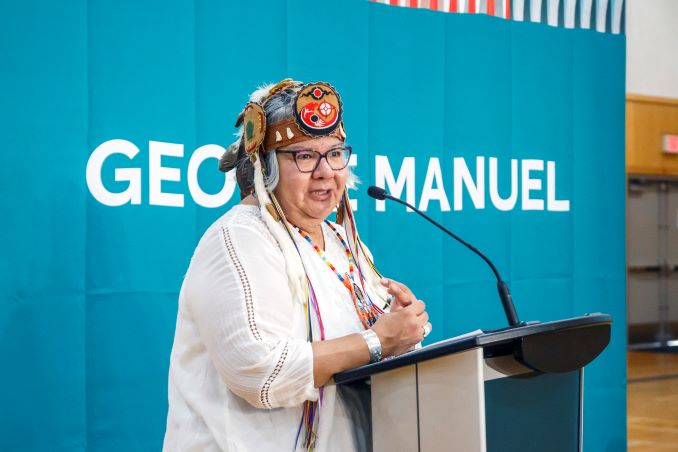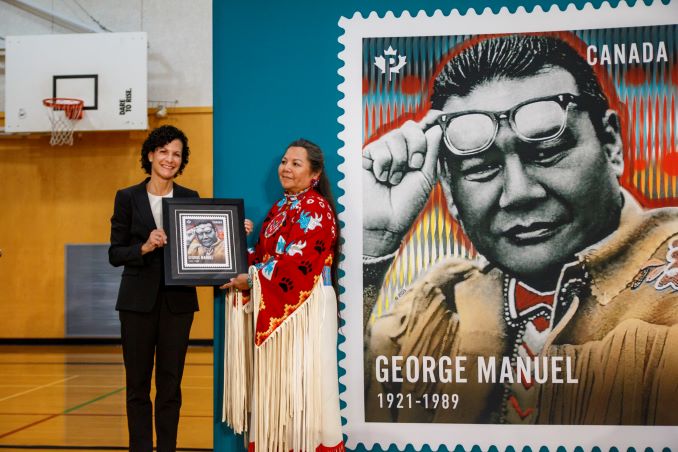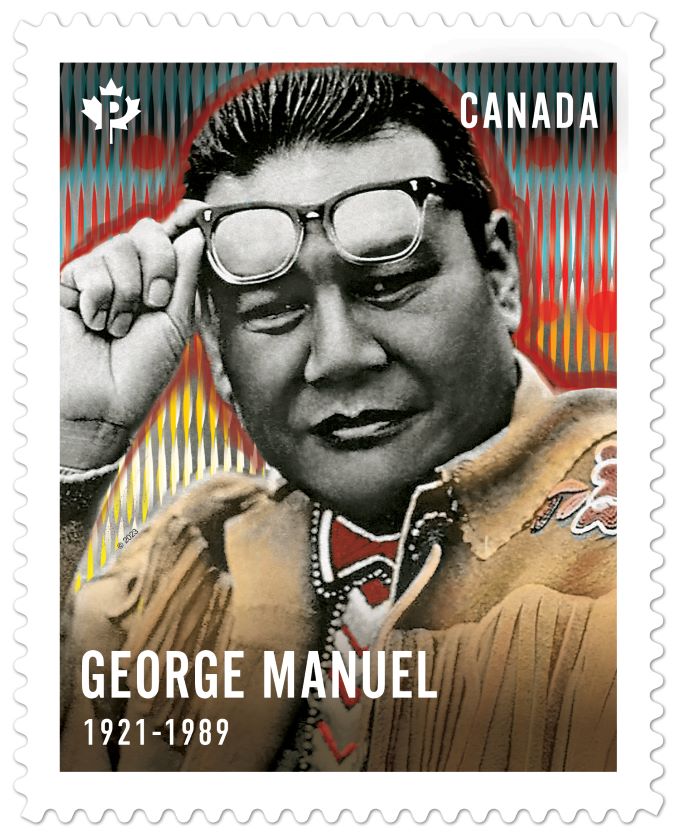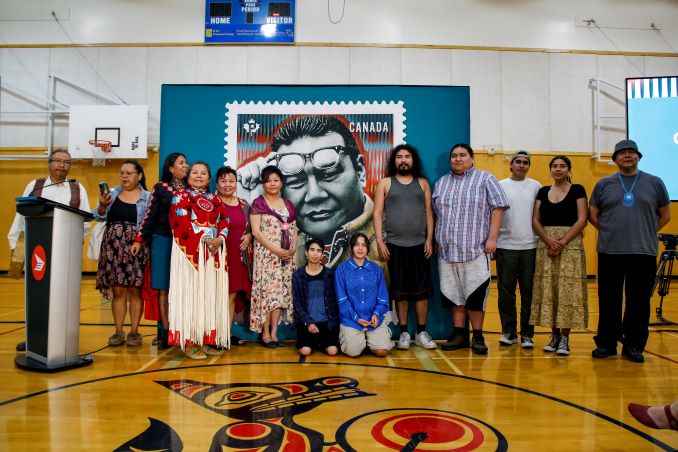Canada Post unveiled three stamps this week honouring three First Nations leaders in BC, N.W.T., and Alberta.
These special stamps are part of the second Indigenous Leaders series, which will be issued on June 21, National Indigenous Peoples Day, at three separate local events. This second release celebrates the legacies of three Indigenous activists: Nellie Cournoyea, George Manuel, and Thelma Chalifoux, recognizing their dedication to fighting for Indigenous rights.

The first series was launched last year to highlight the contributions of modern-day First Nations, Inuit, and Métis leaders who have shown commitment to preserving their cultures and improving the quality of life for Canadian First Nations peoples.
The first stamp paying tribute to Nellie Cournoyea was unveiled on June 11 in Ulukhaktok, N.W.T. She was an advocate for social justice and women’s and Indigenous rights.
Cournoyea was born in Aklavik, Northwest Territories, an Inuvialuit of Canada’s western Arctic, and fought for Indigenous self-determination. She led several organizations, including the Committee for Original Peoples’ Entitlement and the Inuvialuit Regional Corporation.
She had a radio career and later became a land claims fieldworker before her election to the legislature in 1979. Cournoyea became the first Indigenous woman to head a provincial or territorial government in Canada, as Premier of the Northwest Territories from 1991-95.
As co-founder of the Committee for Original Peoples’ Entitlement, she helped negotiate the Inuvialuit Final Agreement, which included a land settlement of more than 90,000 square kilometres. She also participated in creating Nunavut. After she left the Premier’s office, she headed the Inuvialuit Regional Corporation for 20 years.
She was awarded the Officer of the Order of Canada. Now in her eighties, she is the chair of the Nutrition North Canada Advisory Board and vice-chair of the Tuktoyaktuk Community Corporation.
Cancelled in Aklavik, Northwest Territories (Cournoyea’s birthplace), the stamp features a photo of Cournoyea taken in 2022 by Peggy Jay. The Official First Day Cover and the inside of the booklet feature a photograph of Cournoyea taken in 1993 by Tessa Macintosh. That image is superimposed over a photograph taken at Trout Lake, Northwest Territories, by Robert Postma.
The cancellation mark, illustrated by Tania Willard, is a white (or Arctic) fox, one of the symbols on the Northwest Territories coat of arms.

The second stamp honoured British Columbian George Manuel (1921-89), a member of the Neskonlith Indian Band of the Secwepemc Nation. Manuel was an author and political leader who inspired the modern Indigenous movement in Canada. He lobbied for the inclusion of Indigenous and treaty rights in the Canadian Constitution in a four-decade-long political career. Manuel also worked to unite Indigenous Peoples around the world.
George Manuel served as National Chief of the Assembly of First Nations from 1970 to 1976. Then, he became the first president of the World Council of Indigenous Peoples and the Union of British Columbia Indian Chiefs. His efforts contributed to the recognition and affirmation of existing Indigenous and treaty rights in the Constitution Act, 1982.

Manuel was nominated three times for the Nobel Peace Prize. He died on November 15, 1989, in Kamloops, British Columbia.
Cancelled in Chase, B.C., his birthplace, this stamp reworks a black and white image taken of Manuel in the 1970s. According to Canada Post, Secwepemc artist Tania Willard’s colorful designs illustrate the “shining light” of Manuel’s message for international Indigenous rights, while the deep red ochre evokes the pictographs and unique markings found on Secwepemc lands.
The stamp honouring George Manuel was unveiled at the Tsleil-Waututh Nation Community Centre in North Vancouver on Monday, June 12. Guests at the unveiling included George Manuel’s friends and family, including his daughter Doreen Manuel, his son George Manuel Jr., and Ida Manuel.

Other officials attending the ceremony included Elder Amy George and Councillor Charlene Aleck of the Tsleil-Waututh Nation, National Chief Rose Anne Archibald, Susan Margles, Chief People and Safety Officer, Canada Post, and local Indigenous drummers.
A third and final stamp in this series, honouring Thelma Chalifoux, was unveiled on June 13 in St. Albert, Alta. She was a Métis leader and the first Indigenous woman appointed to the Senate of Canada.
Born in Calgary, Alberta, Chalifoux (1929-2017) left an abusive marriage and fought for custody of her children after they were placed in the child welfare system. She became a fieldworker with what is now the Métis Nation of Alberta. Chalifoux co-founded the Slave Lake Native Friendship Centre, which provides services to Indigenous people. She also ran Slave Lake’s first safe house for women leaving violent homes. As a land claims negotiator from 1979 to 1982 and 1996 to 1998, she participated in constitutional talks in the early 1980s to recognize First Nations, Métis, and Inuit Peoples as separate nations.

In 1997, she became the first Indigenous woman appointed to the Senate, where she created provincial Indigenous social assistance, education, and housing programs. After retiring in 2004, she founded Michif Cultural Connections and the St. Albert’s Meadowview Centre for Women’s Health and Wellness. She also served as an Elder at the Nechi Institute: Centre of Indigenous Learning and was Métis Elder in Residence at the Northern Alberta Institute of Technology. She died on September 22, 2017, at the age of 88.
Cancelled in Calgary, Alberta (Thelma Chalifoux’s birthplace), the stamp features a photo of Chalifoux from the Northern Alberta Institute of Technology. The background shows part of a painting by Métis visual artist Christi Belcourt, “The Celebration,” illustrating Chalifoux’s love of flowers.
The new stamps and collectibles will be available at canadapost.ca and postal outlets across Canada beginning June 21.

